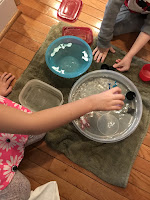Consumable gifts - gifts that will get used up and not take up space forever - are great for adults AND kids! Some of my favorite gifts for adults are …
- restaurant gift cards for a night out
- collections of note cards and greeting cards, wrapped up with some stamps
- seeds and pots to plant and nurture
- specialty spices/ ingredients with a favorite recipe
…. You get the picture!
So, why not take this concept and apply it to THE KIDS! There’s something for everyone!
For your kiddo Mechanic:
Hit the hardware store for a collection of bolts and washers and screws and nuts to put in a small “toolkit” container and let your child have fun with this self-made STEM kit. Extra points if you find a small board and drill holes in it to work on - don’t forget to sand down those rough spots :)
For your little Scientist:
Put together a sturdy magnifying glass (Lakeshore has some good ones) and some plastic containers with lids. These will be collection cups - put in a sample of pine cones, seeds, shells, etc. but leave lots of room for additions by your scientists.
For your budding Writers/Artists:
A box of scrapbook paper, construction paper, and sticky notes will be exciting for these kiddos. Add in scissors, glue sticks, stick-on Googly eyes, etc. and some writing tools to complete a card or book-making kit.
For the kiddo Bakers/Chefs:
Sometimes supplies of their own inspire new hobbies! Start with a favorite recipe and add a few special utensils to create interest :) Plastic bowls and small rolling pins, spoons, recipe books, cookie cutters, and mini pans are all possibilities for baking kits. There are toy versions of baking kits or you can make your own and present it in a little cloth bag or box.
Most of all, think of all the interaction that can take place while using these kits, and have fun planning together!!
Happy Holidays!!






























